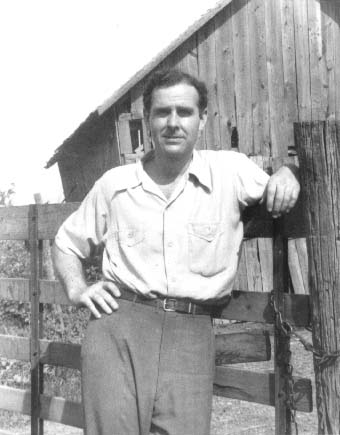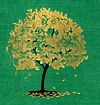From the Dictionary of Midwestern Literature (DML - Vol. 1) May 2001

BIOGRAPHY: Ross
Lockridge, Jr., novelist, was born in Bloomington, Indiana, son
of an historian father and a psychologist mother. After moving
to Indianapolis and then Fort Wayne, Indiana, his family returned
in 1924 to Bloomington, where Lockridge continued his formal
schooling, excelling in all subjects. He frequently accompanied
his father on his excursions throughout Indiana, during which
Ross Senior, well known as "Mr. Indiana," evoked local
heroes in public oratorical performances that he termed "historic
site recitals."
Entering Indiana University in
1931, Ross Lockridge, Jr. spent his junior year abroad at the
Sorbonne, taking highest honors among foreign students. Returning
to Indiana University, where he was known as "A plus Lockridge,"
he graduated with the highest academic average ever accumulated
there. In 1937, he married his high school sweetheart, Vernice
Baker, while teaching as a graduate student in the Department
of English and writing a 400-page epic poem, "The Dream
of the Flesh of Iron" (unpublished).
Accepting a scholarship to Harvard
in 1940, he announced that he would write a doctoral dissertation
on Walt Whitman. Actually, he began writing, in 1941, a novel
based in part on his mother Elsie Shockley's side of the family.
In 1946, now the father of four children, he carried the twenty-pound
manuscript of Raintree County to Houghton Mifflin's offices
in a battered suitcase. Accepted within five weeks, the novel,
prior to publication, was excerpted in Life magazine,
won an enormous prize given by MGM along with a movie contract,
and was the Main Selection of Book-of-the-Month Club. Lockridge
revised the novel in a lake cottage in Manistee, Michigan, and
visited Hollywood with his wife late in 1947. He and his family
then moved back to Bloomington.
Published on January 5, 1948, Raintree
County received mostly lavish reviews. But Lockridge was
already deeply depressed for a multitude of reasons that eluded
the public eye. Two months following publication, and one day
before his novel was announced the number one national best seller,
he took his own life by carbon monoxide poisoning. His obituary
was carried on the front page of The New York Times.
SIGNIFICANCE:
In Raintree County Ross Lockridge unabashedly aspired
to write the Great American Novel, not a regional novel, but
he anchored his 1,060-page narrative in nineteenth-century Midwestern
history, folklore, and landscape. The novel incorporates many
rites, customs, and linguistic practices of Hoosier culture in
a carnivalesque atmosphere, and has been called, by Joel Jones
and Charles Trueheart, at least the "Great American Studies
Novel."
Set in a mythical Indiana county
based partly on Henry County, Indiana, the novel tells the life
story of John Wickliff Shawnessy in a series of flashbacks occasioned
by the events of a single day, July 4, 1892. It thus owes much
to Joyce--as well as to such Midwestern writers as Anderson,
Clemens, Dos Passos, Dreiser, Garland, Hemingway, Lardner, Lewis,
Lincoln, Masters, and Tarkington. But Lockridge attempted an
encyclopedic fiction that would be more accessible than Ulysses,
as William York Tillyard noted early on, to the common reader.
Its form is cinematic, indebted to Intolerance and Citizen
Kane; its plot is based on Hawthorne's story, "The Great
Stone Face"; and its themes reflect Lockridge's absorption
in myth, environment, sexuality, and the need for reaffirmation
of American idealism in the midst of cultural decline.
SELECTED WORKS: Raintree County (1948) is Ross Lockridge's only novel. At his death he left a large archive of unpublished material, some of which is now in the Lilly Library of Indiana University and the Houghton Library of Harvard University. Most materials remain, as of this writing, in the possession of his family. [Note that since this was written in 1998 most if not all materials that were in possession of his family as of 2014 are now in the Lilly Library.]
Lilly Library of Indiana University:
--Archives Online -- Lockridge mss. circa 1837-2000 consist
of the correspondence, unpublished manuscripts, photos, papers,
and much more, some 75,000 items pertaining to the life and work
of Ross Lockridge, Jr. To an Inventory.
And this: Lockridge
mss. III, circa 1837-2000. The Ross Lockridge, Jr. Archive
- A Descriptive Bibliography, 448 pp. as prepared for the
Lilly Library collection by Larry Lockridge is now available
on line here.
Houghton Library of Harvard University:
http://128.103.150.214/houghton/mss/index.html
FURTHER READING:
Book-length studies include Larry Lockridge's full-scale critical
biography, Shade of the Raintree: The Life and Death of Ross
Lockridge, Jr. (1994), and John Leggett's Ross and Tom:
Two American Tragedies (1974), which narrates Lockridge's
life as well as that of Thomas Heggen, author of Mister Roberts.
A notable doctoral dissertation is Delia Clark Temes's "The
American Epic Tradition and Raintree County" (University
of Syracuse, 1973).
Early journalistic reviews and
review essays include James Baldwin's negative "The American
Myth" in New Leader (10 Apr 1948), 10, 14; Howard
Mumford Jones's "Indiana Reflection of U.S. 1844-92"
in Saturday Review 31 (3 Jan 48), 9-10, which observed
that the novel had ended a long slump in American fiction; Nanette
Kutner's "Ross Lockridge, Jr.: Escape from Main Street"
in Saturday Review 31 (12 June 1948), 6-7, 31, which includes
a portrait of Lockridge's final days; Charles Lee's "Encompassing
the American Spirit" from the New York Times Book Review
(4 Jan 1948), 5, 21, the review Lockridge himself liked best;
and William York Tindall's "Many-leveled Fiction: Virginia
Woolf to Ross Lockridge" in 10 (Nov, 1948), 65-71.
Journalistic reviews and review
essays on the occasion of the novel's republication in 1994,
simultaneous with publication of Shade of the Raintree,
include Richard Bausch's "Success and the American Novelist"
in the Los Angeles Times Book Review (15 May 1994), 2; Bruce
Cook's "Raintree Revisited" in the Chicago
Tribune Books (29 May 1994), 3; Scott Donaldson's "Nowhere
to Go but Down" in the Washington Post Book World
(10 Apr 1994), 11; Christopher Lehmann-Haupt's "Novelist's
Work and Death" in the New York Times (2 May 1994),
C13; Tim Page's "In Search of Raintree County" in Newsday
(17 Nov 1994), 1, 4-5, 7 (pt 2); and Charles Trueheart's "The
Great American Studies Novel" in Atlantic Monthly
(Sept, 1994), 105-11. Of the score of major 1994 reviews, only
Trueheart's is, on balance, negative; several critics reconfirm
Lockridge's early high estimate of his own novel, which remains,
however, in problematic relationship to the American canon.
Notable critical essays include
Daniel Aaron's "On Ross Lockridge's Raintree County"
in Classics of Civil War Fiction, ed. David Madden and
Peggy Bach (1991), 204-14; Joseph Blotner's"Raintree
County Revisited" in Western Humanities Review
10 (Winter, 1956), 57-64, and his Introduction to Raintree
County (1984), xiii-xvii; Fred Erisman's "Raintree
County and the Power of Place" in Markham Review
8 (Winter, 1979), 36-40, which makes a case for the novel as
ecological fiction; Park Dixon Goist's "Habits of the Heart
in Raintree County" in MidAmerica XIII (1986),
94-106; Donald Greiner's deeply considered "Ross Lockridge
and the Tragedy of Raintree County" in Critique:
Studies in Modern Fiction 20 (1978), 51-63; Joel Jones's
"The Presence of the Past in the Heartland: Raintree
County Revisited" in MidAmerica IV (1977), 112-21;
Leonard Lutwak's "Raintree County and the Epicising Poet
in American Fiction" in Ball State University Forum
13 (Winter, 1972), 14-28, which contains a close structural analysis;
Darshan Singh Maini's "An Ode to America: A Reconsideration
of Raintree County" in Essays in American Studies,
ed. Isaac Sequeira (India, 1992), 142-49; and Gerald Nemanic's
"Ross Lockridge, Raintree County, and the Epic of
Irony" in MidAmerica II (1975), 35-46. David D. Anderson
has edited a collection of critical essays, Myth, Memory,
and the American Earth: The Durability of Raintree County
(1998).
Larry Lockridge
New York University
June 27, 1998
To the Dictionary of Midwestern Literature (DML - Volume 2) with an updated and greatly expanded synopsis on Ross Lockridge, Jr. The author is one of 35 entries "on pivotal Midwestern literary works...." DML - Volume 2, subtitle"Dimensions of the Midwestern Literary Imagination", Philip A. Greasley, General Editor, published by IU Press, 7/27/2016, 1080 pp, 154 b&w illus., 20 maps.

| The Novel | Essays | Other Writings | RL Jr. Writer's Award | Complete Contents | Book Orders |
| The Biography | Photos / Postcards | RC Source & Facsimiles | Suicide & Prevention | Movie & Score |